Introduction to Deoksugung Palace PART 2
배준민 /
2023-04-20
HERITAGE
조회수 411
-
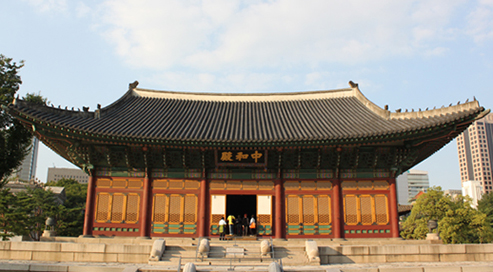
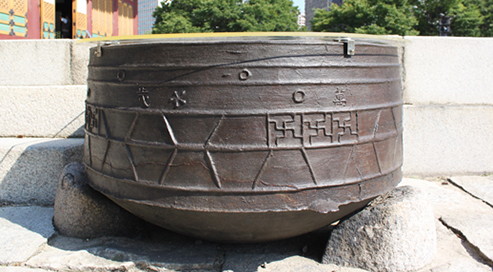
-
Around Junghwajeon, there is a two-tier platform used for ceremonies built to show dignity. These platforms were only built for important buildings. When there was a ceremony here, the court musicians played and performed in the lower platform, and the King and the royal family took seats on the upper platform. The large pot in front of the building was used for putting out fire and it was believed to be effective in repelling fire monsters by showing the ugly reflection of its face on the water. There is a lid on top now because visitors often mistake it for a trash can and put litter in it. This bronze incense burner has three legs symbolizing the king’s authority, majesty and wealth. It is only places in Deoksugung palace and Gyeongbokgung palace. It is because Gyeongbokgung was the main palace of Joseon Dynasty and Deoksugung was the main palace of the Korean Empire. It is a symbol that signifies the authority of the king and it asks the gods for a blessing for the people. The color of the palace doors are usually green but these doors are painted gold because gold is the color of an emperor. 중화전 주변에는 예식에 사용되고 위엄을 나타내는 2단의 월대가 있습니다. 이 월대는 중요한 건물들에만 설치되었습니다. 이곳에서 의식이 있을 때, 궁정 악사들이 아래층에서 연주하고 공연을 했고, 왕과 왕족들이 위층에 자리를 잡았습니다. 건물 앞에 있는 큰 냄비는 불을 끄는 데 사용되었고, 물 위에 흉측한 얼굴을 반사해 보여줌으로써 화마를 물리치는 데 효과적이라고 믿었습니다. 방문객들이 종종 그것을 쓰레기통으로 착각하고 쓰레기를 넣기 때문에 지금은 뚜껑을 설치해두었습니다. 이 청동 향로는 왕의 권위와 위엄, 부귀를 상징하는 세 개의 다리가 있습니다. 덕수궁과 경복궁에만 있는 곳입니다. 경복궁은 조선시대의 정궁이었고 덕수궁은 대한제국의 정궁이었기 때문입니다. 그것은 왕의 권위를 나타내는 상징이고 신들에게 백성들을 위한 축복을 요청합니다. 궁전 문들의 색은 보통 녹색이지만, 금색은 황제의 색이기 때문에 이 문들은 금색으로 칠해져 있습니다. 사진1: http://www.heritage.go.kr/heri/gungDetail/imgDetail.do?detail_code=9&gung_number=4&img_serial_number=465&imgGubun=1&language= 사진2: http://www.heritage.go.kr/heri/gungDetail/imgDetail.do?detail_code=9&gung_number=4&img_serial_number=467&imgGubun=1&language=
-
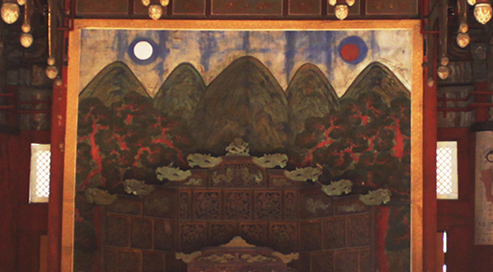
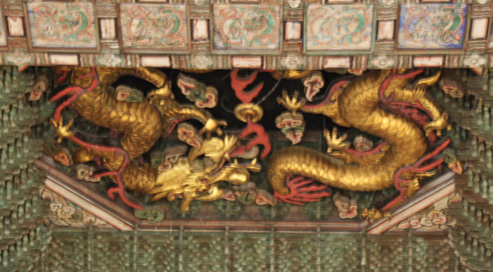
-
Inside Junghwajun, the king’s chair is decorated with dragon patterns which symbolizes the king or the emperor. The wall screen behind the king’s chair is called Ilwol Ohbyungdo. The sun is the king, the moon is the queen, the five mountains are the territory of Hanyang the capital of Joseon, the pine trees are the loyal officials and the waves are the people. This whole picture stands for hopes of a peaceful reign. On a ten thousand Korean Won bill, you will be able to find this Ilwol Ohbyungdo printed in the middle section of the bill. This picture was always drawn where the king presides. In Joseon times, they were rarely allowed to draw the face of the king so they put this Ilwol Ohbyungdo instead to show the place where the king presides. There are golden dragons are carved on the ceiling. The reason why there are two of them when there is only one king is because there was a popular theory of yin and yang, meaning negative and positive, that everything needed to exist in pairs. 중화전 내부에는 왕의 의자가 왕이나 황제를 상징하는 용 무늬로 장식되어 있습니다. 왕의 의자 뒤에 있는 벽체는 일월오병도라고 불립니다. 해는 왕이요, 달은 왕비요, 오산은 조선의 수도 한양의 영토요, 소나무는 충신이요, 파도는 백성입니다. 이 모든 그림은 평화로운 통치에 대한 희망을 상징합니다. 1만원권 지폐에는 지폐 가운데 부분에 일월오병도가 인쇄되어 있습니다. 이 그림은 항상 왕이 주재하는 곳에서 그려졌습니다. 조선시대에는 왕의 얼굴을 그리는 것이 거의 허용되지 않았기 때문에 왕이 주재하는 곳을 보여주기 위해 이 일월오병도를 대신 배치했습니다. 천장에는 황금 용들이 조각되어 있습니다. 왕이 하나밖에 없는데 용이 두 마리 있는 것은 당시에 모든 것이 쌍을 이루어 존재해야 한다는 음양설이 유행이었기 때문입니다. 사진1: http://www.heritage.go.kr/heri/gungDetail/imgDetail.do?detail_code=9&gung_number=4&img_serial_number=477&imgGubun=1&language= 사진2: http://www.heritage.go.kr/heri/gungDetail/imgDetail.do?detail_code=9&gung_number=4&img_serial_number=476&imgGubun=1&language=#
-
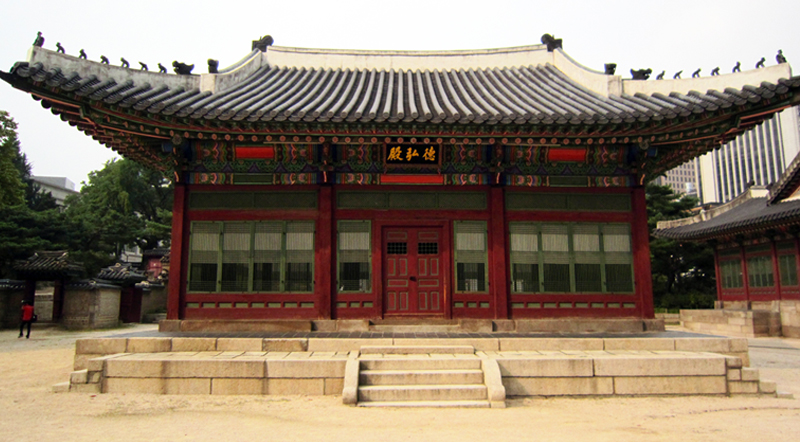
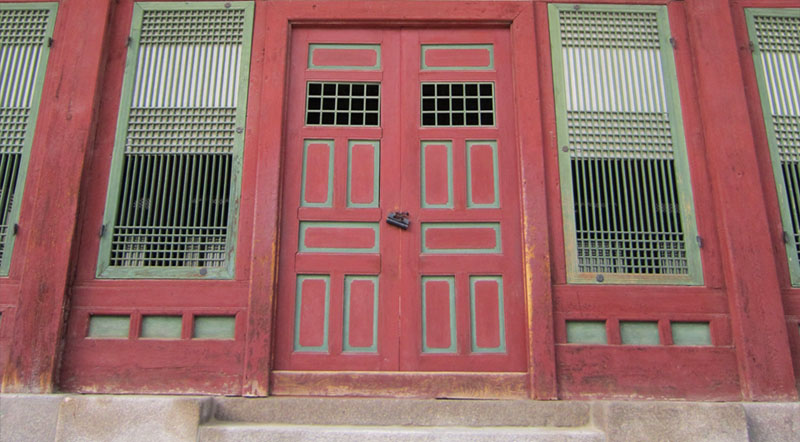
-
Deokhongjeon hall is the king’s office hall and a reception hall for foreign envoys. It is different from other buildings because it has a chandelier that is lit by electricity. The Edison company built a power station in Gyeongbokgung and installed electric bulbs. This was before China or Japan began using such light bulbs and it was Asia’s first electric bulb installed. There is a plum blossom between the two pillars. The plum blossom was the emblem of the Korean Empire so you can find many such patterns in Deoksugung palace. Also, the head of the phoenix means the peace in the country. It is because Pheonix is an imaginary animal that only apears when the land is peaceful. 덕홍전은 왕의 집무실이자 외국 사신들의 영접실입니다. 전기로 불을 밝히는 샹들리에가 있다는 점이 다른 건물들과는 다릅니다. 에디슨 회사는 경복궁에 발전소를 짓고 전구를 설치했습니다. 이것은 중국이나 일본이 그러한 전구를 사용하기 시작하기 전이었고 그것은 아시아 최초로 설치된 전구였습니다. 두 기둥 사이에 오얏꽃이 보입니다. 오얏꽃은 대한제국의 상징이었기 때문에 덕수궁에서 그런 무늬를 많이 볼 수 있습니다. 또한, 봉황의 머리는 나라의 평화를 의미합니다. 이는 봉황은 땅이 평화로울 때만 나타나는 상상의 동물이기 때문입니다. 사진1: http://www.heritage.go.kr/heri/gungDetail/imgDetail.do?detail_code=15&gung_number=4&img_serial_number=258&imgGubun=1&language=# 사진2: http://www.heritage.go.kr/heri/gungDetail/imgDetail.do?detail_code=15&gung_number=4&img_serial_number=259&imgGubun=1&language=#
-
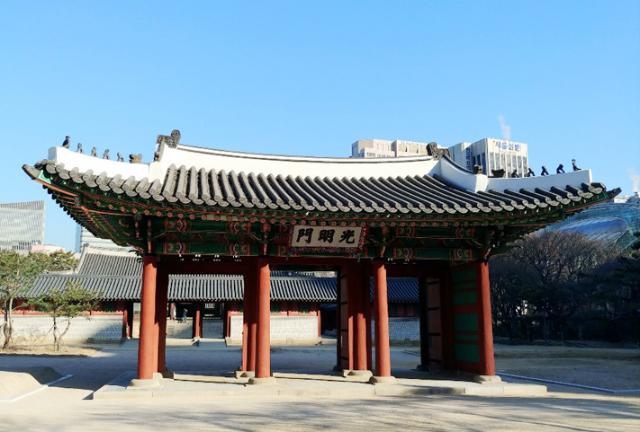
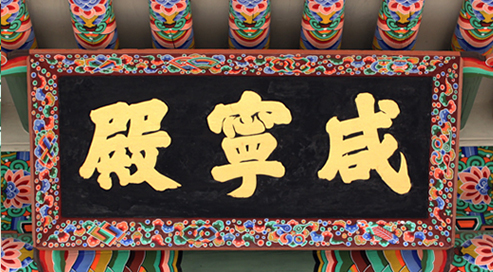
-
Gwangmyeongmun is the main gate to the emperor’s living quarters. It used to have a stone fence like the other gates but they are now gone. This gate had been moved by the Japanese during the Japanese colonial period but the Korean government moved it back to its original place and restored it in 2019. Hamnyeongjun hall is the emperor’s living quarters. The word Hamnyeong means everybody is peaceful. King Gojong’s concubine stayed in the west room and King Gojong stayed in the east room. King Gojong died in 1919 in Hamnyeongjeon hall. It started the people’s independent movement because the official who observed King Gojong’s body wrote about the black lines and other details of the body which lead people to suspect that King Gojong was poisoned by the Japanese. There was a big fire that had started from a fireplace in 1904. People suspected that Japan had intentionally set the fire because the location of the fireplace would have made it very difficult for the palace to catch fire from it. An English news reporter named Bethel wrote about this and made it known to the world. 광명문은 황제의 거처로 들어가는 정문입니다. 예전에는 다른 문들처럼 돌담이 있었지만 지금은 없어졌습니다. 이 문은 일제 강점기에 옮겨져 유물로 전시되었습니다. 일제강점기가 끝난 뒤 한국 정부는 다시 원래의 자리로 옮겨 2019년 복원했습니다. 함녕전은 황제의 거처입니다. 함녕이라는 단어는 모든 사람이 평화롭다는 것을 의미합니다. 서쪽 방에는 고종의 후궁이, 동쪽 방에는 고종이 머물렀습니다. 고종은 1919년 함녕전에서 사망했습니다. 고종의 시신을 관찰한 관리가 검은 선을 비롯한 시신의 세부 사항을 기록해 고종이 일본인에 의해 독살당했다는 의혹을 샀기 때문에 민중의 독립운동이 시작된 것입니다. 1904년 벽난로에서 시작된 큰 화재가 있었습니다. 사람들은 일본이 벽난로의 위치 때문에 궁전에서 불이 나는 것을 매우 어렵게 만들었기 때문에 의도적으로 불을 지른 것이라고 의심했습니다. 영국의 한 뉴스 리포터인 Bethel은 이것에 대해 쓰고 그것을 세계에 알렸습니다. 사진1: http://www.heritage.go.kr/heritage/heritage_pop/detailImgPop.jsp?gung_number=4&file_name=mode_general_10_01.jpg 사진2: http://www.heritage.go.kr/heri/gungDetail/imgDetail.do?detail_code=14&gung_number=4&img_serial_number=486&imgGubun=1&language=#